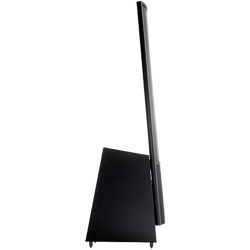Loading ...
Loading ...
Loading ...

22
diaphragm treated with a conductive coating. This
model confirmed Janszen’s beliefs, for it exhibited
remarkable phase and amplitude linearity.
Janszen was so excited with the results that he
continued research on the electrostatic speaker
on his own time. He soon thought of insulating the
stators to prevent the destructive effects of arcing.
By 1952, he had an electrostatic tweeter element
ready for commercial production. This new tweeter
soon created a sensation
among American audio
hobbyists. Since Janszen’s
tweeter element was
limited to high frequency
reproduction, it often found
itself used in conjunction
with woofers—most
notably, those from
Acoustic Research. These
systems were highly
regarded by all audio enthusiasts.
As good as these systems were, they would soon
be surpassed by another electrostatic speaker.
In 1955, Peter Walker published three articles
regarding electrostatic loudspeaker design in
Wireless World, a British magazine. In these
articles, Walker demonstrated the benefits of
the electrostatic loudspeaker. He explained that
electrostatics permit the use of diaphragms that
are low in mass, large in area and uniformly
driven over their surfaces by electrostatic forces.
Due to these characteristics, electrostats have the
inherent ability to produce a wide bandwidth, flat
frequency response with distortion products being
no greater than the electronics driving them.
By 1956, Walker backed up his articles by
introducing a consumer product, the now famous
Quad ESL. This speaker immediately set a
standard of performance for the audio industry
due to its incredible accuracy. However, in actual
use, the Quad had a few problems. It could not be
played very loud, it had poor bass performance, it
presented a difficult load that some amplifiers did
not like, its dispersion was very directional and its
power handling was limited to around 70 watts.
As a result, many people continued to use box
speakers with cones.
In the early 1960’s Arthur Janszen joined
forces with the KLH
loudspeaker company,
and together they
introduced the KLH 9.
Due to the large size
of the KLH 9, it did not
have as many sonic
limitations as the Quad.
The KLH 9 could play
markedly louder and
lower in frequency than
the Quad ESL. Thus a rivalry was born.
Janszen continued to develop electrostatic designs.
He was instrumental in the design of the Koss
Model One, the Acoustech and the Dennesen
speakers. Roger West, the chief designer of the
Janszen Corporation, became the president of
Sound Lab. When Janszen Corporation was sold,
the RTR loudspeaker company bought half of
the production tooling. This tooling was used to
make the electrostatic panels for the Servostatic,
a hybrid electrostatic system that was Infinity’s first
speaker product. Other companies soon followed;
each with their own unique applications of
the technology. These include Acoustat,
Audiostatic, Beveridge, Dayton Wright, Sound
Lab and Stax, to name a few.
Electrostatic speakers have progressed and
prospered because they actually do what Peter
Walker claimed they would. The limitations and
problems experienced in the past were not inherent
These developments
allow the consumer
to own the highest
performance loudspeaker
products ever built.
Loading ...
Loading ...
Loading ...
